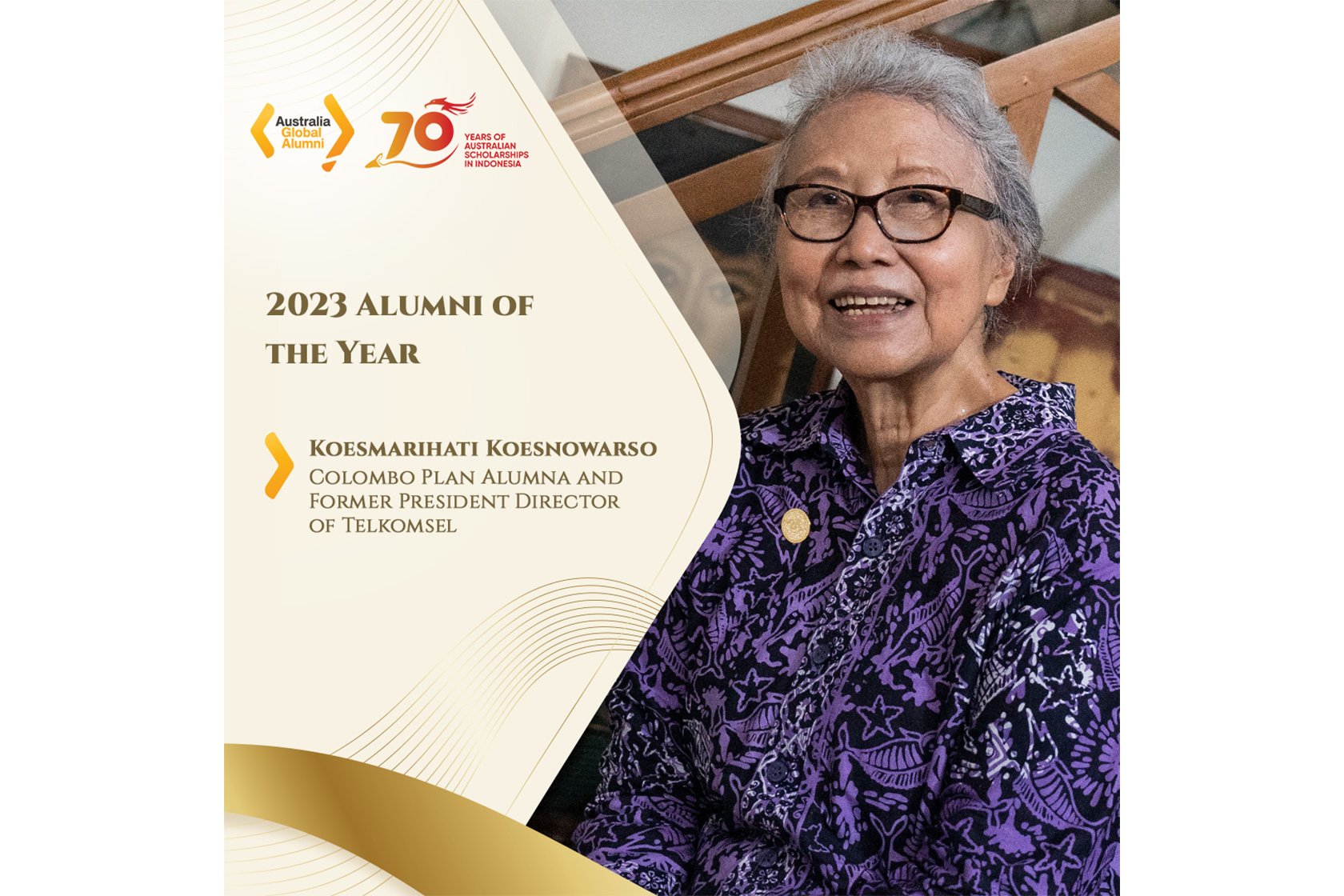The 2023 Alumni of The Year. Koesmarihati graduated with a bachelor’s degree in electrical engineering from the University of Tasmania in 1965 under the Colombo Plan scholarship scheme.
The telecommunication industry in Indonesia remains a male-dominated sector that rarely puts women in C-suite roles. There is one extraordinary woman, however, who has made a permanent crack in the glass ceiling. Her name is Koesmarihati Koesnowarso, and she is recognised as the most influential woman in Indonesian telecommunications history.
She had a long career with state-owned telco PT Telkom and later its subsidiary Telkomsel, creating a series of regulatory and technological breakthroughs. As the first CEO of cellular phone operator Telkomsel, she has been credited for the company’s success in becoming the largest player in the industry with wide coverage across the archipelago—the position the company has attained until now.
When she first took office in 1995, Telkomsel made a breakthrough by separating telecommunication services and mobile devices, making the devices much more affordable for the market, and reducing the average cost of a device from Rp14 million to Rp1-4 million. The company first carried out this breakthrough independently before finally being supported by the government on a national scale in 2000.
“I said, the company already had a huge network; let’s just focus on selling the network through phone cards. For the device, leave it to the market. Let’s introduce an open distribution channel, establish dealers all over the country, and create more jobs,” said Koesmarihati on the then-controversial decision in a recent interview at her home in South Jakarta.
Following her retirement from the company, she was appointed as an official at the Indonesian Telecommunications Regulatory Body (BRTI), representing the public. She did not oppose the liberalisation of the country’s telco sector, but she insisted that local players must also have a share in the market.
At BRTI, she drafted a road map for cellular phone number portability, which allowed a single code in Indonesia, enabling phone users to change operators without having to lose their familiar phone number.
Now 81 years old, Koesmarihati remains an active member of the Indonesian Telecommunications Society. She also teaches at Telkom University and the University of Indonesia and serves as a consultant, board member, and advisor of the Telecommunication and Information Accessibility Body (Bakti).
Brave being the operative word
Koesmarihati graduated with a bachelor’s degree in electrical engineering from the University of Tasmania in 1965 under the Colombo Plan scholarship scheme. Along with fellow Indonesian student Trismiati Harsono, they became the first women to graduate from the university’s School of Engineering.
“We were called [the] two brave ladies who took up engineering in our faculty,” she said, adding that Trismiati now resides in the United States.
Koesmarihati attributed their bravery and courage to her parents, Koesnowarso and Koesmarinah. Serving as a government forestry inspector in West Java back in the 1940s, Koesnowarso once sat down the family of seven children, saying that he had to sign a statement siding with the Dutch colonial government.
“He said that he would not be able to face us if he became a chameleon (country’s traitor). He said the Dutch colonial [officials] would target him so that he would be on the run for a while,” Koesmarihati said, reminiscing about how the colonial officials were shooting at her father’s car.
Her father came back after a couple of years in hiding but passed away in 1951, leaving her mother to work hard to raise the children and make ends meet as they relocated to her grandmother’s house in Madiun, East Java.
Back then, Koesmarihati was already a bright student with a talent for math and science, but the family could not afford to send her to college. Fortunately, she was selected for the Colombo Plan as she was one of Madiun's best-performing high school graduates.
Telecommunication the path to gender equality
Following her graduation from the University of Tasmania, Koesmarihati worked briefly at the Hydro Electric Commission in Hobart and PMG (now Telstra) in Melbourne before finally deciding to return home to work in the infrastructure and telecommunications industries.
In Indonesia, she worked at the state utility company PLN’s Laboratory and for the Dutch company Nederlandse Kabelfabriek (NKF). Koesmarihati then joined Telkom in 1976, working on a project connecting the network cables in Jakarta and Greater Jakarta. She initiated the utilisation of the latest fibre optic technology, first used in the United States in 1977. The project pioneered the use of fibre optic cables in Indonesia, which earned her the prestigious Satya Lencana Pembangunan award from the Indonesian government for her extraordinary contribution to the country.
In 1993, Koesmarihati was appointed as Telkom’s Development Director, in charge of laying the foundation of cellular technology and developing GSM technology. She succeeded in both and was promoted to become the first President Director of Telkomsel in 1995—the first woman in the country ever to lead a telecommunications company.
She said women are certainly as capable as men in any sector. Still, in the reality where gender equality has yet to be achieved, it is important to have male allies to set a level playing field and make sure that women get a seat at the table.
“I don’t think I would have been able to rise to the top without the trust of the Minister of Tourism, Postal, and Telecommunication at that time, the late Soesilo Soedarman. There were many contenders back then to become directors, but he nominated me because he said he liked how I never minced my words,” Koesmarihati said, laughing.
She said she is glad that it is now a different era where more women are promoted to the top levels faster. However, the telecommunications industry still lags behind as no woman has been appointed as a regional head.
“I hope women’s access to technology and their role in the telecommunication sector can be improved. The internet can really expand the horizon of women,” said Koesmarihati, who is a recipient of the Distinguished Alumni Award and Doctor of Honoris Causa in Engineering from the University of Tasmania.


 Koesmarihati Koesnowarso and Her Trailblazing Journey to Crack the Telco Industry’s Glass Ceiling
Koesmarihati Koesnowarso and Her Trailblazing Journey to Crack the Telco Industry’s Glass Ceiling
